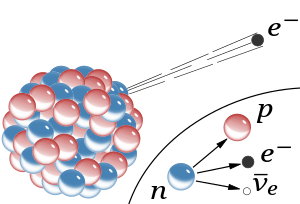
Back Desintegració de neutrons lliures Catalan Désintégration du neutron libre French Бета-распад нейтрона Russian
This article provides insufficient context for those unfamiliar with the subject. (January 2023) |

β−
radiation, the emission of a fast electron from the nucleus (the accompanying antineutrino is omitted). In the Rutherford model for the nucleus, red spheres were protons with positive charge and blue spheres were protons tightly bound to an electron with no net charge. : The inset shows beta decay of a free neutron as it is understood today; an electron and antineutrino are created in this process.
When embedded in an atomic nucleus, neutrons are (usually) stable particles. Outside the nucleus, free neutrons are unstable and have a mean lifetime of 877.75+0.50
−0.44 s[1] or 879.6±0.8 s[2] (about 14 min and 37.75 s or 39.6 s, respectively). Therefore, the half-life for this process (which differs from the mean lifetime by a factor of ln(2) ≈ 0.693) is 611±1 s (about 10 min, 11 s).[3][4]
The beta decay of the neutron described in this article can be notated at four slightly different levels of detail, as shown in four layers of Feynman diagrams in a section below.
The hard-to-observe
W−
quickly decays into an electron and its matching antineutrino. The subatomic reaction shown immediately above depicts the process as it was first understood, in the first half of the 20th century. The boson (
W−
) vanished so quickly that it was not detected until much later.
Later, beta decay was understood to occur by the emission of a weak boson (
W±
), sometimes called a charged weak current. Beta decay specifically involves the emission of a
W−
boson from one of the down quarks hidden within the neutron, thereby converting the down quark into an up quark and consequently the neutron into a proton. The following diagram gives a summary sketch of the beta decay process according to the present level of understanding.

| 3 quark composite neutron ( n0 ) |
3 quark composite proton ( p+ ) |
||||||
| ︷ | ︷ | ||||||
| ( u d d ) |
→ | ( u d u ) |
+ | W− |
|||
| ⤷ | e− |
+ ν e | |||||
| ︸ | |||||||
| subsequent W− decay | |||||||
- The down quark shown in bold (
d
) is nominally the one emitting the boson (
W−
) and thereby changing into an up quark (
u
), also in bold. The
u
d
quark pair not shown in bold are inert bystanders to the whole event.
For diagrams at several levels of detail, see § Decay process, below.
- ^ Cite error: The named reference
Gonzalez-2021was invoked but never defined (see the help page). - ^ Cite error: The named reference
PDG-2020-n-lifewas invoked but never defined (see the help page). - ^ Cite error: The named reference
Beringer-etal-2012-PDG-010001was invoked but never defined (see the help page). - ^ Cite error: The named reference
PDG-2007-baryons-LPLwas invoked but never defined (see the help page).
© MMXXIII Rich X Search. We shall prevail. All rights reserved. Rich X Search